
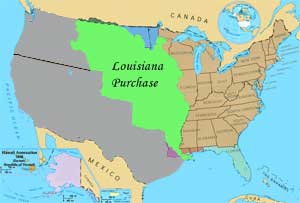 The Louisiana Purchase was the acquisition by the United States of more than 529,911,681 acres (827,987 mi² or 2,144,476 km2) of territory from France in 1803, at the cost of about 3¢ per acre (7¢ per hectare); $15 million or 80 million francs in total. (If adjusted for the relative share of GDP, this amount would equal approximately $390 billion in 2003, or about $1800 per hectare.) The Louisiana Purchase was the acquisition by the United States of more than 529,911,681 acres (827,987 mi² or 2,144,476 km2) of territory from France in 1803, at the cost of about 3¢ per acre (7¢ per hectare); $15 million or 80 million francs in total. (If adjusted for the relative share of GDP, this amount would equal approximately $390 billion in 2003, or about $1800 per hectare.)
The French territory of Louisiana included far more land than just the current U.S. state of Louisiana. The lands purchased contained parts or all of present-day Arkansas, Missouri, Iowa, Minnesota west of the Mississippi River, North Dakota, South Dakota, Nebraska, New Mexico, northern Texas, Oklahoma, Kansas, the portions of Montana, Wyoming, and Colorado east of the Rocky Mountains, the portions of southern Manitoba, southern Saskatchewan and southern Alberta that drain into the Missouri River, and Louisiana on both sides of the Mississippi River including the city of New Orleans. The land included in the Purchase comprises 22.3 percent of the territory of the modern United States.

The city of New Orleans controlled the Mississippi River, which was already important for shipping agricultural goods to and from the parts of the US west of the Appalachian Mountains. Through Pinckney's Treaty signed with Spain on October 27, 1795, American merchants had "right of deposit" in New Orleans, meaning they could use the port for th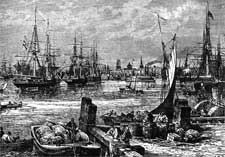 eir goods. Americans were fearful that they would lose their rights of use to New Orleans. The Jefferson administration decided that the best way to assure long term access to the Mississippi would be to purchase the city of New Orleans and the nearby portions of Louisiana east of the Mississippi. Jefferson sent James Monroe and Robert R. Livingston to Paris to negotiate such a purchase. Livingston was to pursue a purchase of New Orleans, but he was rebuffed by the French. In 1802, Pierre Samuel du Pont de Nemours was enlisted to help negotiate. Du Pont was living in the U.S. at the time and had close ties to Jefferson, as well as to the political powers in France. He engaged in back channel diplomacy with Napoleon, eir goods. Americans were fearful that they would lose their rights of use to New Orleans. The Jefferson administration decided that the best way to assure long term access to the Mississippi would be to purchase the city of New Orleans and the nearby portions of Louisiana east of the Mississippi. Jefferson sent James Monroe and Robert R. Livingston to Paris to negotiate such a purchase. Livingston was to pursue a purchase of New Orleans, but he was rebuffed by the French. In 1802, Pierre Samuel du Pont de Nemours was enlisted to help negotiate. Du Pont was living in the U.S. at the time and had close ties to Jefferson, as well as to the political powers in France. He engaged in back channel diplomacy with Napoleon, 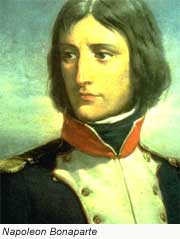 on Jefferson's behalf, during a personal visit to France. He originated the idea of the much larger Louisiana Purchase as a way to defuse potential conflict between the U.S. and Napoleon over North America. on Jefferson's behalf, during a personal visit to France. He originated the idea of the much larger Louisiana Purchase as a way to defuse potential conflict between the U.S. and Napoleon over North America.
Lacking sufficient military forces in America, Napoleon needed peace with England to implement the San Ildefonso treaty and take possession of Louisiana. In the beginning of the year 1803, war between France and England seemed increasingly unavoidable. These circumstances led Bonaparte to abandon his plans to rebuild France's New World empire. On 11 April 1803, just days before Monroe's arrival, Marquess de Barbé-Marbois, Napoleon's minister of the treasury, offered Livingston all of Louisiana instead of just New Orleans.

The American negotiators were prepared to spend $2 million for New Orleans, but were dumbfounded when the entire region was offered for $22.5 million. The Louisiana territory was vast, stretching from the Gulf of Mexico in the south to Rupert's Land in the north, and from the Mississippi River in the east to the Rocky Mountains in the west. Acquiring the territory would double the size of the United States at a cost of less than 3 cents per acre ($7 per square kilometer). Although not authorized to make such a large purchase, Monroe and Livingston recognized the historical significance of the opportunity and accepted Napoleon's offer.
The American purchase of the Louisiana territory was not accomplished without domestic opposition. The Federalists strongly opposed the purchase, favoring close relations with Britain over closer ties to Napoleon. The Federalists argued that the purchase was unconstitutional, and that the U.S. had paid a large sum of money just to declare war on Spain. The Federalists also feared that the political power of the Atlantic seaboard states would be threatened by the new citizens of the west, bringing about a clash of western farmers with the merchants and bankers of New England.

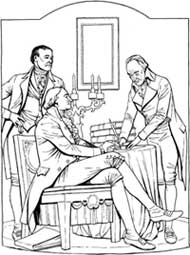 On April 30, 1803, the Louisiana Purchase Treaty was signed by Robert Livingston, James Monroe, and Barbé Marbois at Paris. Jefferson announced the treaty to the American people on July 4. On April 30, 1803, the Louisiana Purchase Treaty was signed by Robert Livingston, James Monroe, and Barbé Marbois at Paris. Jefferson announced the treaty to the American people on July 4.
The United States Senate ratified the treaty on October 20; on the following day, it authorized President Jefferson to take possession of the territory and establish a temporary military government. In legislation enacted on October 31, Congress made temporary provisions for local civil government to continue as it had under French and Spanish rule and authorized the President to use military forces to maintain order. Plans were also set forth for a mission to explore and chart the territory, which would become the Lewis and Clark expedition.
Effective on October 1, 1804, the purchased territory was organized into the Orleans Territory (most of which became the state of Louisiana) and the District of Louisiana, which was temporarily under the control of the Indiana Territory.

The Louisiana Purchase led to a dispute between the United States and Spain over the boundaries of the area the United States had bought. In 1810, after a revolt in West Florida, the United States annexed the region between the Mississippi and Pearl rivers (known today as the Florida Parishes of Louisiana). In 1812, the Mobile District was annexed (the region between the Pearl and Perdido Rivers, which now forms the panhandles of Alabama and Mississippi). The matter was not fully settled until the signing of the Adams-Onís Treaty in 1819, in which Spain ceded all of Florida to the U.S. and the boundary between the Louisiana territory and the Spanish colonies was set along the Sabine, Red and Arkansas rivers and the 42nd parallel.
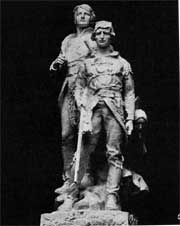 When purchased, the boundaries of "Louisiana" were not defined, and the land itself was generally unknown (which led to the Lewis and Clark expedition). In particular, not wanting to anger Spain, France refused to specify the southern and western boundaries. Estimates that did exist as to the extent and composition of the purchase were initially based on the explorations of Robert LaSalle. If the US owned all the tributaries of the Mississippi on its western side, the Purchase extended into Canada. When purchased, the boundaries of "Louisiana" were not defined, and the land itself was generally unknown (which led to the Lewis and Clark expedition). In particular, not wanting to anger Spain, France refused to specify the southern and western boundaries. Estimates that did exist as to the extent and composition of the purchase were initially based on the explorations of Robert LaSalle. If the US owned all the tributaries of the Mississippi on its western side, the Purchase extended into Canada.
|